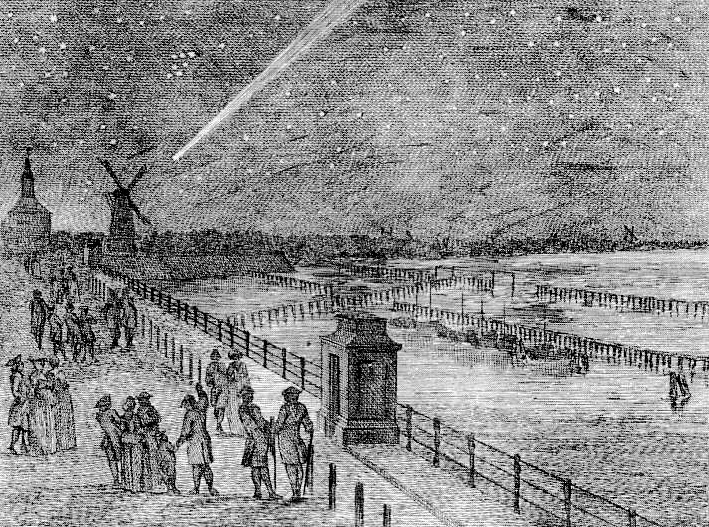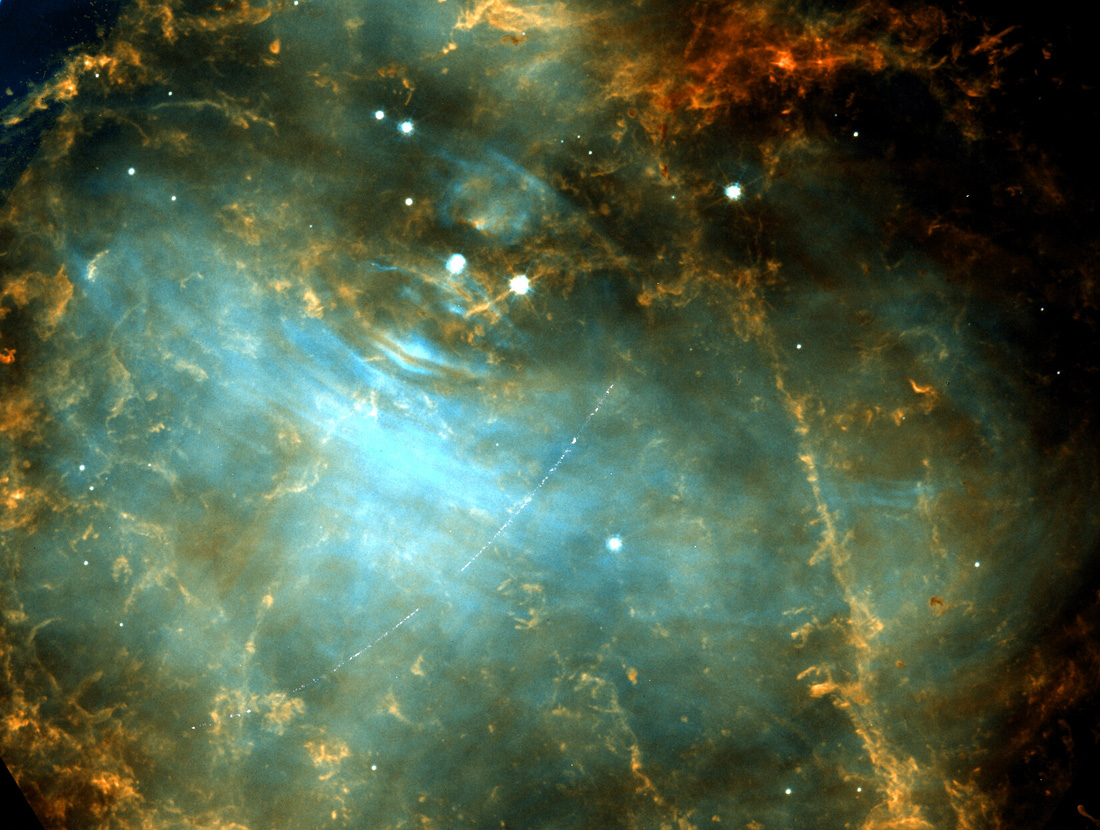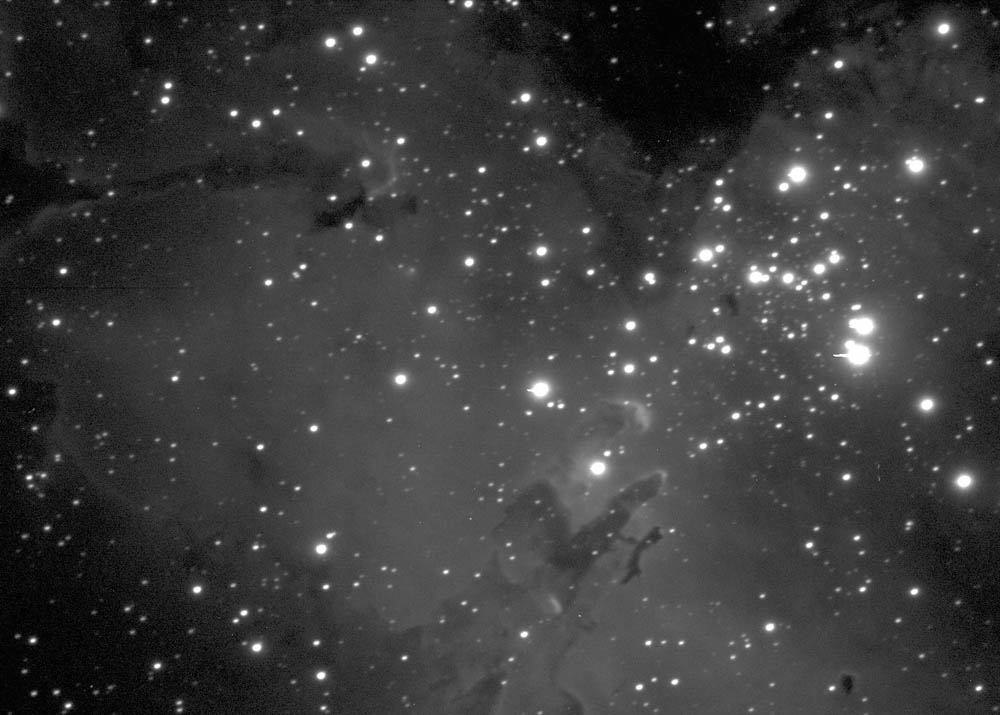
Perihelion: 1769 October 8.12, q = 0.123 AU
As discussed in the “Special Topics” presentation on that object, in the early 18th Century the British astronomer Edmond Halley predicted that the comet that now bears his name would be returning around 1758. As that time approached several astronomers became involved in the effort to search for it. One of these was an enthusiastic French astronomer, Charles Messier, who worked at the Marine Observatory in Paris (funded by the French Navy) under the supervision of astronomer Joseph-Nicolas Delisle. In mid-August 1758 he did manage to find a comet, however this one had been discovered three months earlier by a fellow French astronomer, Jean Baptiste de la Nux. Messier nevertheless followed de la Nux’s comet, and on August 28 he noticed a similar diffuse object in the same telescopic field of view; unlike a comet, however, this object stayed in the same location night after night. Messier eventually did find Comet Halley in January 1759, however he had been beaten to it almost a month earlier by German amateur astronomer Johann Palitzsch.
This entire series of events inspired Messier to devote his life to comet hunting, and over the next four decades he became the champion comet discoverer of his era. He claimed a total of 21 comet discoveries, although some of these were made after they had been found by other astronomers, and modern catalogs generally credit him with somewhere between 12 and 15 discoveries. He apparently went about this effort single-mindedly, and an oft-repeated anecdote – which may very well be apocryphal – relates how when he had to tend to his wife during a long illness (to which she eventually succumbed), one of his competitors, Jacques Montaigne, discovered a comet. After his wife’s passing, when a friend stopped by to console him for his “loss,” he supposedly replied “Alas, I have discovered a dozen comets, only to be robbed of my thirteenth by that Montaigne!” Then, realizing what he had just said, he corrected himself, “Ah, the poor woman.”

The object that Messier found on August 28, 1758 while he was examining Comet de la Nux was what we now call the Crab Nebula, located in Taurus. It is a large cloud of glowing gas, created by a massive star that exploded as a supernova in 1054 and which was observed by Chinese astronomers as well as in Europe and Arabia and by Native Americans (where it appears on a pictograph at Chaco Canyon in New Mexico). As an aid for himself and other comet-hunters Messier compiled a list of these stationary “nuisance objects” as he came across them in his search efforts, so that he and others would not waste their time on them. He eventually cataloged 103 such objects, although in more recent years astronomers have identified additional objects in Messier’s notes and have added seven more to the overall catalog.
In a rather ironic twist of fate, Messier today is primarily known not for the comets he so single-mindedly hunted, but rather for this list of “nuisance objects” that he compiled while engaged in that activity. Indeed, Messier’s catalog contains many of the nighttime sky’s brightest and/or scientifically most important star clusters, gaseous and dusty nebulae, and galaxies, and continues to be referenced by astronomers all the time.

Some of Messier’s comets were nevertheless bright or otherwise important in some way. One of the most important ones is a comet he discovered on June 14, 1770, which then passed just 0.015 AU from Earth at the beginning of July, the closest confirmed cometary approach to Earth in history. The story of this comet, which was named for the mathematician who computed its orbit, Anders Lexell, is related in a previous “Special Topics” presentation.
Messier discovered what would be his best and brightest comet on the evening of August 8, 1769. At that time it was located within the constellation Aries and dimly visible to the unaided eye, and was slowly traveling eastward. It brightened rapidly, being 4th magnitude with a 6-degree tail in mid-August, and by the end of that month had brightened to almost 2nd magnitude and was exhibiting a tail at least 15 degrees long. Around that time it was independently spotted by the British naval explorer Captain James Cook aboard the HMS Endeavour in the South Pacific, who reported the tail as being over 40 degrees long.

The comet continued to brighten rapidly, and accelerate its travel towards the east-southeast, as it approached Earth, with the minimum distance being 0.32 AU on September 10. At that time the comet, then located a few degrees southwest of the bright star Procyon, was close to magnitude 0, with reported tail length measurements being from 60 to over 90 degrees. Thereafter it traveled rapidly towards morning twilight, being last detected on September 26, by which time it was close to magnitude -1 (albeit in the dawn sky) and still exhibiting a bright tail several degrees long.
Comet Messier remained hidden in sunlight for the next four weeks, and was finally picked up again on the evening of October 23, still visible to the unaided eye close to the horizon, with a tail approximately 2 degrees long. It remained on the far side of the sun from Earth as it receded and faded, with the last observations being obtained on December 1.

The French ruler Napoleon Bonaparte was born on August 15, 1769, just one week after Messier’s discovery of this comet, and supposedly referred to this object as his “protecting genie.” Messier himself was well aware of this “connection,” and in 1808 while facing declining health and financial difficulties self-published a memoir linking his 1769 comet with the Emperor in an apparent attempt to curry favor with him. There is no real evidence that Napoleon took much notice of this memoir, however. For whatever it’s worth, another comet – the Great Comet of 1811, which is a future “Comet of the Week” – is the comet most associated with Napoleon.
In a true final irony to Messier’s legacy there have been approximately half a dozen comets that have been discovered by astronomers, both professional and amateur, while observing deep-sky objects in Messier’s catalog. For example, in 1892 a British amateur astronomer, Edwin Holmes, was engaged in observing the Andromeda Galaxy, M31, when he noticed a bright comet nearby; that object, now known as Comet 17P/Holmes, has turned out to be a most remarkable short-period comet that is a future “Comet of the Week.” And, of course, it was while observing the globular star cluster M70 in Sagittarius in July 1995 that Thomas Bopp in Arizona and I independently discovered the comet that bears our names, which would become one of the brightest comets of the 20th Century.
More from Week 35:
This Week in History Special Topic Free PDF Download Glossary
Ice and Stone 2020 Home Page


